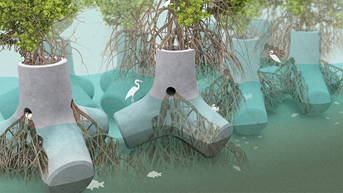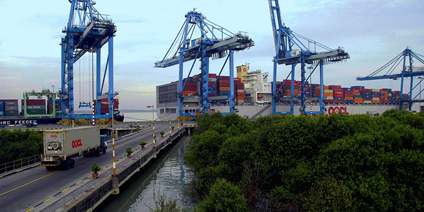
Sustainable Development of Ports in Australia
With the high demand for intercontinental shipping, driven by the growth of world trade and AustraliaŌĆÖs almost total reliance on shipping as an enabler of all imports and exports, there is a constant need for new port development projects. When this is coupled with the increased scrutiny of climate change influences, the environment will become the most important aspect of new port design, construction and subsequent operations.
Port developments are being progressed in increasingly complex socio/regulatory environments, with growing environmental awareness amongst project proponents, shareholders, regulators and contractors. Progressive port developers are taking ownership of their responsibilities by promoting the design and implementation of more sustainable port solutions, including operational methodologies.
Design
Ports are facing continuous changes concerning new ship developments, new cargo handling technology and environmental requirements, all of which present challenges for the design of ports. Green ports need to not only offset carbon emissions and turn to green energy sources, but also provide net nature benefit through the creation of new and improved habitats for marine and terrestrial flora and fauna.

An environmentally sensitive design philosophy can be used to create opportunities for sustainable port developments as seen in the port of Kuala Tanjung, in Malaysia. Here, the use of nature-based solutions for breakwaters and marine infrastructure has been successfully implemented. The ability of mangroves to realise significant wave attenuation is high and this factor enables mangroves to be ŌĆśplantedŌĆÖ into breakwaters and offer operational, environmental, economic and aesthetic benefits to the port.
According to an environmental impact study of the port, the loss of one hectare of mangroves results in a loss of opportunites for fish, shellfish molluscs and prawn habitats with an estimated loss of economic value for fisheries of over $30,000.
Overall, a port expansion project should result in greater fish productivity thanks to an increase in total nursery area. However, to enable implementation and realisation of these types of solutions, the benefits of these approaches need to be understood and taken into account by clients, projects financiers and other stakeholders.
Construction
The dredging (excavation, transportation and disposal) of soft-bottom material may lead to various adverse impacts on the marine environment, especially when carried out near sensitive habitats such as coral reefs or seagrass beds. The cumulative effects on related (adjacent) ecosystems such as mangroves and seagrass meadows (including effects from maintenance dredging cycles) may also have indirect consequences.
A combination of digital monitoring of water quality and coral health during dredging activities, and the modelling of dredging plumes to guide decisions on when to modify (or even stop) dredging, appears to be the most effective approach to minimise negative impacts on seagrass meadows and coral reefs.
Operations
The operations phase of a port development will have the greatest contribution to net environmental impacts. The installation of high voltage shore power for all ship berths is critical for low carbon footprints. This improves the air environment around the port, reduces the surrounding water pollution, optimises the energy structure and reduces the environmental pollution caused by the auxiliary power generation of berthing ships.
Rubber Tired Gantry (RTG) cranes are recommended because they are the most environmentally friendly when used in commercial ports and strike the best tradeoff between environmental protection and profitability. Rail Mounted Cranes (RMC) and Empty Container Handlers (ECH) consume considerable hydrocarbon-based energy. The replacement of outdated equipment or the investment and use of smarter port equipment is a key element of operational sustainability and commercial outcomes (lower operational costs).

Port facilities must also be able to sustainably manage substantial waste generated by shipping operations, such as contaminated oil and other contaminants, including efficient recovery services and disposal facilities. As shipping transitions energy sources initially to LNG and then hydrogen power, these waste streams will significantly reduce in quantity.
Conclusion
Port design, construction and operation with a strong environmental approach involves a dramatic shift from the traditional approach to port development. Well planned and executed port development projects can protect and enhance marine ecosystems, greatly improve port air quality, reduce overall carbon footprints and improve total capital returns both financially and environmentally. This represents a major opportunity for port developers, shareholders, operators and customers to understand the environmental benefits and commercial outcomes of these types of solutions, and ensure they are core to port development projects.
Mainsheet has substantial experience providing independent advice to port development projects, including environmentally sustainable solutions and capital investment business cases. If you would like to know more, please get in touch with us here.
